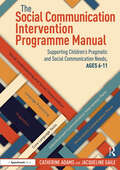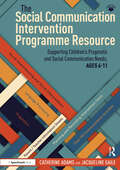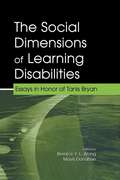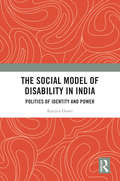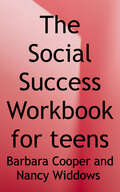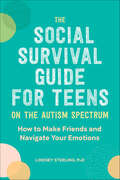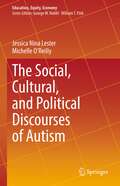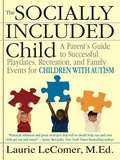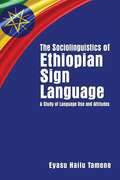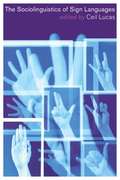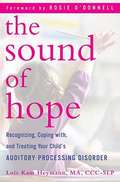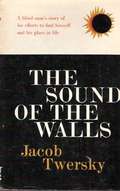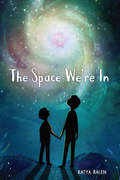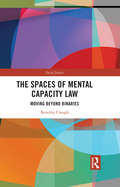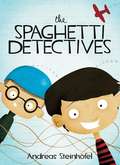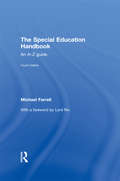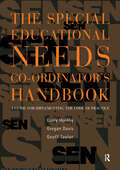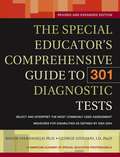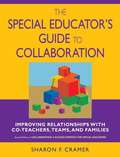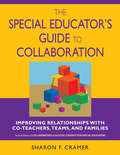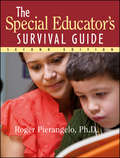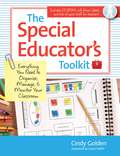- Table View
- List View
The Social Communication Intervention Programme Manual: Supporting Children's Pragmatic and Social Communication Needs, Ages 6-11 (The Social Communication Intervention Programme)
by Catherine Adams Jacqueline GaileThe Social Communication Intervention Programme (SCIP) has been developed to support school-aged children (6–11 years) with social communication, pragmatic, and language needs. The Social Communication Intervention Programme Manual provides a rationale and method for providing specialist level language therapy for these children who have significant social communication differences. Evidence for the effectiveness of SCIP is included in The Manual.This book introduces the SCIP model and explores the three main components: social understanding/social inference, pragmatics, and language processing. Guidance is included on how to link assessment with therapy, how to plan and individualise interventions, and how to proceed with the programme. It contains a wealth of real-life case examples to illustrate key points, with step-by-step instructions for carrying out the interventions.Used alongside The Social Communication Intervention Programme Resource, this book offers a truly practical, tried-and-tested model to provide targeted, individualised intervention for children with social communication challenges. It is an essential tool for speech and language therapists, specialist teachers, and psychologists who are working with children with social communication, pragmatic, and language needs.For the most effective use, The SCIP Manual should be purchased alongside The SCIP Resource.
The Social Communication Intervention Programme Resource: Supporting Children's Pragmatic and Social Communication Needs, Ages 6-11 (The Social Communication Intervention Programme)
by Catherine Adams Jacqueline GaileThe Social Communication Intervention Programme (SCIP) has been developed to support school-aged children (6–11 years) with social communication, pragmatic, and language needs. SCIP provides a rationale and method for providing specialist level pragmatics and language therapy for these children who have significant social communication differences.The SCIP model is introduced in The Social Communication Intervention Programme Manual, and this book presents the content of the intervention programme itself, using a nested structure of 150 adaptable therapy activities. It contains the complete set of resources required to plan and deliver the interventions set out in the companion book, including forms, activities, and ready-made information sheets. Content can also be downloaded and printed for easy use.Used alongside The Social Communication Intervention Programme Manual, this book offers a truly practical, tried-and-tested model to provide targeted, individualised intervention for children with social communication challenges. It is an essential tool for speech and language therapists, specialist teachers, and psychologists who are working with children with social communication, pragmatic, and language needs.For the most effective use, The SCIP Resource should be purchased alongside The SCIP Manual.
The Social Dimensions of Learning Disabilities: Essays in Honor of Tanis Bryan (The LEA Series on Special Education and Disability)
by Bernice Y. L. Wong Mavis L. DonahueBringing together over 25 years of research into the social aspects of learning disabilities (LD), this book presents a range of topics that reflect on the richness of research interests in the discipline. In honor of Tanis Bryan, the pioneer in research on social competence of children with LD, the researchers that follow her lead systematically examine critical issues in the social relationships of these children. The book begins by placing the work of Bryan and her research associates' in context, in terms of the prevailing theoretical frameworks and social political influences that led to the enormous impact of the work. The chapters that follow discuss: *social cognition in children and adolescents with LD; *self-understanding and self-esteem in children and adults with LD; *the lonely plight, peer influence, and friendship patterns of children with LD; *parental understanding and how this understanding shapes their scaffolding of learning in their children with language disabilities; *a new intervention approach toward enhancing self-concept and reading comprehension in LD students through bibliotherapy; *important and timely information on interventions for enhancing peer relations and preventing drop-out in adolescents; *models in longitudinal research with implications for research on social dimensions of LD; and *the important role of teachers in enhancing classroom social experiences for students with LD. Summarizing research findings and their implications in the various areas in the field, this book will be an excellent text for a special topics course in graduate programs in learning disabilities, special education, psychology, and social work. In addition, it will be a highly important resource for university/college teachers, researchers, graduate and honors students, and professionals in learning disabilities, social psychology, and social work.
The Social Model of Disability in India: Politics of Identity and Power
by Ranjita DawnThis book presents various paradigms and debates on the diverse issues concerning disability in India from a sociological perspective. It studies disability in the context of its relationship with concepts such as culture/religion, media, literature, and gender to address the inherent failures in challenging prevalent stereotypical and oppressive ideologies. It traces the theological history of disability and studies the present-day universalized social notions of disablement. The volume challenges the predominant perception of disability being only a medical or biological concern and provides deeper insight into the impact of representation through an analysis of the discourse and criteria for ‘normalcy’ in films from the nineteenth and twentieth centuries. It analyzes the formation of perspectives through a study of representation of disability in print media, especially children’s literature, comics, and graphic novels. The author also discusses the policies and provisions available in India for students with disabilities, especially women who have to also contend with gender inequality and gender-based discrimination. The book will be of interest to scholars and researchers of disability studies, educational psychology, special education, sociology, gender studies, politics of education, and media ecology. It will also be useful for educationalists, NGOs, special educators, disability specialists, media and communication professionals, and counsellors.
The Social Sources of Adjustment to Blindness
by Irving Faber Lukoff Martin WhitemanThe impact of society on the blind is a complex issue, and many different tacks are necessary even if we are to only make little headway through the eddies and currents that alter and modify people's lives. This study is focused on the social forces that influence the adaptation of blind persons. The information derives from almost 500 interviews with blind persons selected from all walks of life.
The Social Success Workbook for Teens: Skill-building Activities for Teens with Nonverbal Learning Disorder, Asperger's Disorder and other Social-skill Problems (Instant Help Solutions Series)
by Barbara Cooper Nancy WiddowsMaking friends is a skill like any other-there are rules to follow, ways to measure your progress, and reasons why some people are better at it than others. Although it may seem like this skill comes naturally to those who don't have Asperger's disorder, nonverbal learning disorder (NLD), or other problems relating to others, the reality is that even the most popular people must constantly hone their abilities in order to make new friends and keep the friends they already have. <p><p>This workbook includes forty activities you can do to recognize and use your unique strengths, understand the unspoken rules behind how people relate to each other, and improve your social skills. After completing the activities in this workbook, you will discover that you can get along with others and build friendships despite the challenges you face. All you need is the confidence to be yourself while still keeping the feelings of others in mind.
The Social Survival Guide for Teens on the Autism Spectrum: How to Make Friends and Navigate Your Emotions
by Lindsey SterlingConnect with friends and care for your emotions—for teens on the spectrumSocial situations can feel mysterious or tricky to navigate—and if you are on the autism spectrum, they can feel overwhelming. The Social Survival Guide for Teens on the Autism Spectrum unlocks socialization secrets and helps you understand your feelings. Autism books for kids don't always address teenagers' needs, but the practical tips and step-by-step guides in this handbook are perfect for ages 12-16.Learn how to handle situations like managing anxiety, starting a conversation, understanding sarcasm, and dealing with conflict. Build stronger social skills and take care of your emotional health at the same time. This guide can help you feel more confident—and more connected to people you care about.Build new social interaction skills with:Friend fundamentals—Understand what makes a good friend, and learn about informal conversation, nonverbal communication, online etiquette, and more.Social essentials—Discover strategies for joining a group activity, staying flexible, saying no when you need to, and other topics essential to autism books for kids.Insight into you—You are your friend, too! Learn to recognize and express emotions, boost your mood with positive self-talk, and more.Feel more confident and build valued friendships with this helpful handbook.
The Social, Cultural, and Political Discourses of Autism (Education, Equity, Economy #9)
by Michelle O'Reilly Jessica Nina LesterTaking up a social constructionist position, this book illustrates the social and cultural construction of autism as made visible in everyday, educational, institutional and historical discourses, alongside a careful consideration of the bodily and material realities of embodied differences. The authors highlight the economic consequences of a disabling culture, and explore how autism fits within broader arguments related to normality, abnormality and stigma. To do this, they provide a theoretically and historically grounded discussion of autism—one designed to layer and complicate the discussions that surround autism and disability in schools, health clinics, and society writ large. In addition, they locate this discussion across two contexts – the US and the UK – and draw upon empirical examples to illustrate the key points. Located at the intersection of critical disability studies and discourse studies, the book offers a critical reframing of autism and childhood mental health disorders more generally.
The Socially Included Child
by Laurie Fivozinsky LecomerAn indispensable step-by-step guide for socializing any child on the autism spectrum. Parents of children with autism often end up skipping family functions, playdates, and social outings for fear that their children will be unsafe, behave inappropriately, or feel overwhelmed. Now, no matter a child?s language skills or behaviors, he or she can start participating socially with LeComer?s clear action steps. The Socially Included Child introduces a new organizational tool called the I.D.E.A.L. system, which allows parents to: I: Introduce an Activity D: Determine the Tasks Involved E: Evaluate Your Expectations A: Accommodate for Success L: List the Components of the Activity Visually Here is the essential guide for parents who want to ensure that their children enjoy the benefits?and fun?of socializing, while still accommodating their special needs.
The Sociolinguistics of Ethiopian Sign Language: A Study of Language Use and Attitudes
by Eyasu Hailu TameneEthiopian Sign Language (EthSL) emerged relatively recently; its development is closely tied to the establishment of the first school for deaf students in Addis Ababa by American missionaries in 1963. Today, EthSL is used by more than a million members of the Ethiopian Deaf community, but it remains an under-researched language. In this work, Eyasu Hailu Tamene presents a groundbreaking study of EthSL that touches on multiple aspects of Deaf people’s lives in Ethiopia. Tamene collects data from three principal groups of people: deaf participants, teachers of deaf students, and parents of deaf children. He examines EthSL use within families, in formal and informal settings, and in various community spaces. He documents the awareness among different groups of the services available for deaf people, such as sign language interpreters and Deaf associations. He finds that members of the Deaf community show positive attitudes toward the use of EthSL and investigates the factors that impact those attitudes. His work indicates that there are still critical gaps in recognition and support for the use of EthSL, which can pose a threat to the vitality of the language. The Sociolinguistics of Ethiopian Sign Language will help to advance public understanding of EthSL and contribute to improved educational and social outcomes for the Deaf community in Ethiopia.
The Sociolinguistics of Sign Languages
by Ceil LucasThis is an accessible introduction to the major areas of sociolinguistics as they relate to sign languages and deaf communities. Clearly organized, it brings together a team of leading experts in sign linguistics to survey the field, and covers a wide range of topics including variation, multilingualism, bilingualism, language attitudes, discourse analysis, language policy and planning. Each chapter introduces the key issues in each area of inquiry and provides a comprehensive review of the literature. The book also includes suggestions for further reading and helpful exercises.
The Song of the Stone Wall
by Helen KellerAn unrhymed poem, fashioned from traditional style, first published in 1910 in which a rough, enduring old stone wall, that winds over hill and meadow, becomes a symbol of New England history. Its importance lies in the meaning it held for Helen Keller, and the strength she gained from its existence.
The Sound of Hope: Recognizing, Coping with, and Treating Your Child’s Auditory Processing Disorder
by Lois Kam HeymannThere is more to listening than just hearing. A miraculous process that begins in the womb, learning to communicate is a vital part of expressing oneself and of understanding and interacting with the world. A child's ability to listen well affects every aspect of his or her life. But for some 1.5 million children in the United States who have normal hearing and intelligence, communication and language are blocked. Words are jumbled and distorted. These children have a hard time following directions and become frustrated in trying to make themselves understood, which often leads to unruly behavior, poor school performance, social isolation, and low self-esteem. Auditory Processing Disorder (APD) affects the brain's ability to accurately process the sounds of speech, which in turn impedes the ability to communicate. Experts are just beginning to unlock the mystery of this confounding condition. As a result, APD is often undiagnosed or misdiagnosed. But hope is here. Now veteran speech-language pathologist Lois Kam Heymann offers the first practical guide to help parents dramatically improve the listening and language skills of their children, whether they have a diagnosed auditory processing disorder, slow language development--or simply need practice listening. Inside this reassuring, action-oriented book you'll find * easy-to-identify milestones to help parents pinpoint challenges that may arise during each stage of their child's development from birth to age eight* the tools and checklists needed to assist parents in recognizing APD early* tips to distinguish APD from other listening/learning disorders, including ADD, ADHD, LPD, and PDD* methods to encourage a child's natural listening abilities through books, stories, nursery rhymes, songs, lullabies, toys, and games * home techniques to hone a child's auditory processing--whether he or she has severe APD limitations or just needs to build listening "muscles"* specific suggestions on how to improve a child's listening skills outside the home--at school, during after-school activities, even when at a restaurant* an analysis of traditional classroom settings and effective ways parents can advocate for better sound quality* guidelines for finding the right professionals to work with your child With hands-on ways for improving a child's ability to listen to instructions, process information, and follow directions, parents can turn simple activities into powerful listening lessons in only minutes a day. The bottom line: Learning how to listen in our noisy, complicated world is the key to a happy and engaged child.
The Sound of the Walls
by Jacob TwerskyAs a small child in Poland, Jacob Twersky contracted an illness which left him almost totally blind. His parents hoped that a doctor in the United States could restore their son's sight, and this hope spurred them to emigrate in the mid-1920s. Twersky describes his childhood in Poland and Brooklyn, his years attending a resource room for blind children and a regular high school, and his eventual decision to enroll at a school for the blind. His struggle to accept his blindness is a theme throughout the book, threading its way through his college years, his struggle to find a teaching position, and his courtship and marriage.
The Source for Dyslexia and Dysgraphia (The Source Series)
by Regina G. RichardsThis book seeks to expand the author's holistic approach to the understanding of writing, integrating it with an understanding of reading and takes a thorough look at the areas of reading and writing, omitting comprehension. The information and strategies included in this book are useful in helping the readers describe and understand the child or children within their sphere of concern.
The Space We're In
by Katya BalenTen-year-old Frank has trouble navigating his relationship with his younger brother Max who is autistic.Frank loves soccer, codes, riding his bike, and playing with his friends. His brother Max is five. Max only eats foods that are beige or white, hates baths, and if he has to wear a t-shirt that isn't gray with yellow stripes he melts down down down. Frank longs for the brother he was promised by his parents before Max was born--someone who was supposed to be his biggest fan, so he could be the best brother in the world. Instead, Frank has trouble navigating Max's behavior and their relationship. But when tragedy strikes, Frank finds a way to try and repair their fractured family and in doing so learns to love Max for who he is. In her debut novel, Katya Balen uses her knowledge of autism and experience working with autistic people to create an intriguing and intense yet always respectful family story.For readers of Counting by 7s and The Curious Incident of the Dog in the Nighttime.A Junior Library Guild Selection!
The Spaces of Mental Capacity Law: Moving Beyond Binaries (Social Justice)
by Beverley CloughThis book explores the conceptual spaces and socio-legal context which mental capacity laws inhabit. It will be seen that these norms are created and reproduced through the binaries that pervade mental capacity laws in liberal legal jurisdictions- such as capacity/incapacity; autonomy/paternalism; empowerment/protection; carer/cared-for; disabled/non-disabled; public/private. Whilst on one level the book demonstrates the pervasive reach of laws questioning individuals mental capacity, within and beyond the medical context which it is most commonly associated with, at a deeper and perhaps more important level it challenges the underlying norms and assumptions underpinning the very idea of mental capacity, and reflects outwards on the transformative potential of these realisations for other areas of law. In doing so, whilst the book offers lessons for mental capacity law scholarship in terms of reform efforts at both domestic and internationals levels, it also offers ways to develop our understandings of a range of linked legal, policy and theoretical concepts. In so doing, it offers new critical vantage points for both legal critique and conceptual change beyond mental capacity law. The book will be of interest to researchers in mental capacity law, disability law and socio-legal studies as well as critical geographers and disability studies scholars.
The Spaghetti Detectives
by Andreas Steinhöfel Chantal Wright1 String of Spaghetti + 2 Friends = A Noodle-Cooking, Crime-solving Caper! Sometimes Rico acts a bit odd--his mom calls him a "proddity"--but he's genius at noticing little things nobody else does. Like a string of spaghetti stuck to the sidewalk. Or the big buckteeth of that boy in the blue motorcycle helmet. Or the strange behavior of the neighbors in his apartment building. Oscar is a true prodigy, with a high IQ and high anxieties to match. He's the one who wears the blue helmet--to protect his precious brain! Oscar may have a lot of book smarts, but he needs Rico's help to face his biggest fears. And when other kids mysteriously start going missing, it's up to the two friends to use their noodles, keep track of the clues, and crack the case!
The Special Education Handbook: An A-Z Guide
by Michael Farrell'What a terrific resource: comprehensive and current, this Handbook is a vital acquisition for all involved in special education programs. Dr Farrell writes clearly and with a practical flair ... Highly recommended.' – Michael Arthur-Kelly PhD, Associate Professor and Director, Special Education Centre, University of Newcastle, Australia This acclaimed, bestselling and comprehensive guide, now in a fully updated fourth edition, is an essential reference book for anyone involved with special education. All entries have been reviewed to reflect current practice and the book is enriched with extra resources, including references to useful Internet sites. Focusing on current educational frameworks in the United Kingdom and the United States of America, the author has gathered into one A to Z volume a wide range of information essential to good practice in mainstream and special schools. A thematic index helps the reader plot a course through topics of interest. The broad themes and areas covered are: basic terms, ideas and values venues relating to special education, and school organisation roles and responsibilities individual differences among learners with disabilities and disorders curriculum and assessment, resources and technology pedagogy and classroom organisation therapy and care. Presented in a handy quick reference format The Special Education Handbook also provides a coherent account of the complexities of special education, combining a wealth of practical guidance with the latest research findings. This clear and concise Handbook is indispensable for all those involved in special education, including teachers, teaching assistants, parents, administrators and others.
The Special Educational Needs Co-ordinator's Handbook: A Guide for Implementing the Code of Practice
by Geoff Taylor Garry Hornby Gregan DaviesIn September 1994, the Code of Practice on the Identification and Assessment of Special Educational Needs came into force, and with it a major increase in the expectations placed on teachers in mainstream schools, in particular on the SEN coordinators. This handbook discusses the implications for schools and gives practical guidance on how to implement the code effectively. Throughout, the book provides: * Further information, expanding upon that given in the Code * Examples * Ideas for dealing with SEN in schools * Checklists * Proformas for photocopying and direct use in schools The book begins by explaining and expanding on the Code of Practice, setting it in the context of recent developments including the Education Reform Act and OFSTED criteria for evaluating policy and provision for children in SEN. It then goes on to provide guidelines for implementing the Code of Practice at each of the five stages which it specifies and discusses issues which are raised by this. Specific chapters cover: * Identifying and assessing SEN within the school * Liaison with outside specialists * Statementing * Annual reviews * Knowledge needed by classroom teachers of children with SEN * Implications and issues at different stages of the education system * Parental involvement * Future challenges The book will be of particular interest to special needs coordinators, but will also be of value to anyone else working with children with SEN, including class teachers, heads, advisers, governors, educational psychologists and education welfare officers.
The Special Educator's Comprehensive Guide to 301 Diagnostic Tests
by Roger Pierangelo George Giuliani J.D., Psy.D.This important resource is an update of the best-selling book The Special Educator's Resource Guide to 109 Diagnostic Tests. The greatly expanded second edition contains 301 new and enhanced tests, which are vital to understanding assessment in special education. Designed as an easy-to-use, hands-on resource, the book is filled with practical tools, information, and suggestions. Step-by-step, this practical guide explores the various stages of evaluation, interpretation, diagnosis, prescription, and remediation.
The Special Educator's Guide to Collaboration: Improving Relationships With Co-Teachers, Teams and Families (2nd Edition)
by Sharon F. CramerThe book presents case stories from up-to-date research, reflection activities, structured research and interview activities for developing collaboration skills.
The Special Educator's Guide to Collaboration: Improving Relationships With Co-Teachers, Teams, and Families
by Sharon F. CramerFind case stories from up-to-date research, reflection activities, structured research and interview activities for developing collaboration skills.
The Special Educator's Survival Guide
by Roger PierangeloWritten for educators who work with special children and teens, this second edition of a best-selling classic offers a practical guide to every facet of the special education teacher's job, from teaching in a self-contained classroom or resource room to serving on a multidisciplinary team. This easy-to-follow format, takes you step by step through the various stages required to understand the referral process, parent intakes and conferences, evaluation, interpretation, diagnosis, remediation, placement, individual education plans, classroom management, medication, educational law, and more.
The Special Educator's Toolkit: Everything You Need to Organize, Manage, and Monitor Your Classroom
by Cindy Golden Juane HeflinOverwhelmed special educators: Reduce your stress and support student success with this practical toolkit for whole-classroom organization. A lifesaver for special educators in any Ka 12 setting, this book-and-CD set will help teachers expertly manage everything, from schedules and paperwork to student supports and behavior plans. Cindy Golden, a seasoned special educator, administrator, and psychologist with almost 30 years of experience, has based this teacher-friendly toolkit on her popular OMAC (Organization and Management of All Classrooms) system--an innovative approach to creating effective classrooms for students with all types of disabilities. Special educators will get step-by-step, ready-to-use guidance on managing six key aspects of their daily work: Environment. Make the most of every inch of classroom space Clean out clutter, arrange furniture to improve traffic flow, and construct classroom zones, work stations, and bulletin board displays that support learning. Communication. Implement low-cost communication supports that meet student needs. Make simple picture symbol books, interactive schedules, labels for classroom areas and objects, and more. Teaching Methods and Materials. Determine student needs, create schedules, simplify the IEP process, and pinpoint the best methods for teaching academic, vocational, behavioral, social, and life skills. Behavioral Systems. Organize a successful behavioral system that motivates students, helps them improve behavior and social skills, and uses positive reinforcement techniques. Data and Paperwork. Learn the secrets to creating a simple, logical, highly efficient system for managing paperworka so more time can be spent on teaching. Staff and Home Supports. Build trusting, respectful relationships with classroom staff and parents with stress-free strategies like team meetings and home communication notebooks. For each of these critical areas, special educators will discover dozens of proven strategies, vivid examples, and clever tips and tricks to help them make immediate improvements in their classroom. They'll also get a CD-ROM with more than 60 printable forms and tools they can use right away to support learning, safety, and positive behavior. This is the ultimate guide for every special educator, from the first-year teacher setting up a new classroom to the seasoned veteran who wants a down-to-earth guide to current best practices. Teachers will come away empowered and motivated to get and stay organized--and they'll see the positive results year after year in their classrooms. CD-ROM includes more than 60 printable forms and tools, including Personal Classroom AssessmentClutter Cleaning ChecklistEnvironmental Planning WorksheetCards for Calming DownLunch Visual Schedule PlacematClass Schedule BookletClassroom Expectations ChartFunctional Behavior AssessmentStudent Safety PlanGroup Lesson PlansIndividual Student Lesson PlanIEP and Eligibility CalendarHome and Staff Supports ChecklistHomea School Notesand more "
